Sarah Emsley's Blog, page 4
April 15, 2025
St. Paul’s Church, Halifax and RMS Titanic
Two parishioners from St. Paul’s Church in Halifax, NS were passengers on RMS Titanic. George Wright, a well-known businessman and philanthropist, perished when the steamship sank in the early hours of April 15, 1912 (113 years ago today). Hilda Slayter was on her way from England to British Columbia to be married, and she survived the disaster. Many years later, she was buried in Halifax, in Camp Hill Cemetery.
The Rev’d Samuel H. Prince, curate at St. Paul’s, held a memorial service at the church on April 21st. “Over the whole of the civilized world,” he said, “there rests the shadow of a great sorrow.” He noted that “Some have been spared,” and he prayed, “Please God, there may be more.”
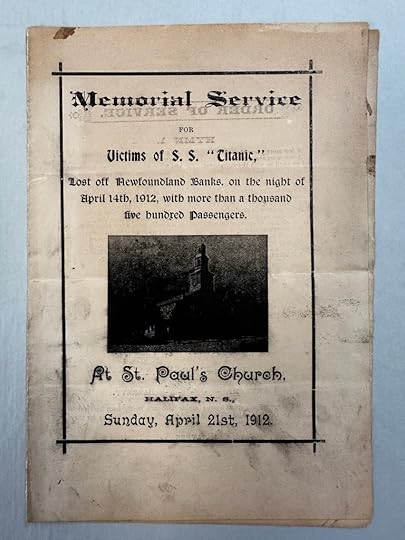
Leaflet for Memorial Service (courtesy of St. Paul’s Church Archives, Halifax, NS)
In early May, Rev’d Prince sailed on the Montmagny to assist with recovering the bodies of victims. He produced a newspaper on board the ship called The Montmagny Moon, which, among other things, included details of the memorial service he held for George Wright. “Here, at the late Mr. Wright’s ocean tomb as a clergyman of his own dear church St. Paul’s,” Prince said, “I was glad to hold a solemn service to his memory.”
He wrote that “it was with deep feelings of awe and heartache that we went over the waters which so recently had closed above more than a thousand six hundred of our brother mortals. As if conscious of the sadness of the situation, the ship’s bell tolled at intervals on the bridge, rung by the winds.”
A couple of weeks ago, I went to hear Deanna Ryan-Meister, President of the Titanic Society of Atlantic Canada, speak at the Maritime Museum of the Atlantic. She gave a fascinating talk about three White Star Line ships, including Titanic, and their connections with Halifax.
I was surprised and pleased to see that she included my book St. Paul’s in the Grand Parade in the collection of books she had on display. The book has a section on the church’s connections with Titanic. I wrote this history of St. Paul’s more than a quarter of a century ago, and it’s been wonderful to see the book receiving new attention now that the church is celebrating its 275th anniversary.
(If you’re interested, you can buy the book from the church or from Woozles, Bookmark, or Block Shop Books.)

Left to right: Deanna Ryan-Meister, Sarah Emsley, Bob Chaulk, and Lynette Richards
It was a pleasure to meet Lynette Richards, author of Call Me Bill, a graphic novel about the wreck of the SS Atlantic, and Bob Chaulk, author of Atlantic’s Last Stop: Courage, Folly, and Lies in the White Star Line’s Worst Disaster Before Titanic and The Dangerous Harbour: Revealing the Unknown Ships and Wrecks of the Halifax Explosion.
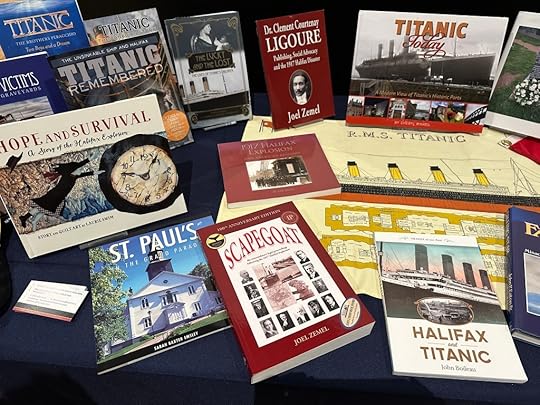
If you enjoyed this post, I hope you’ll consider recommending it to a friend. If you aren’t yet a subscriber, please sign up.
Here are the links to the last two posts, in case you missed them:
A Glorious Spring Day at Jane Austen’s House in Chawton
Anne Shirley and “Old St. John’s Graveyard”
Read more about my books, including St. Paul’s in the Grand Parade, Jane Austen’s Philosophy of the Virtues, and Jane Austen and the North Atlantic, here.
Copyright Sarah Emsley 2025 ~ All rights reserved. No AI training: material on http://www.sarahemsley.com may not be used to “train” generative AI technologies.
April 4, 2025
A Glorious Spring Day at Jane Austen’s House in Chawton
It was a delight to visit Jane Austen’s House Museum in Chawton, Hampshire, on the first day of spring.
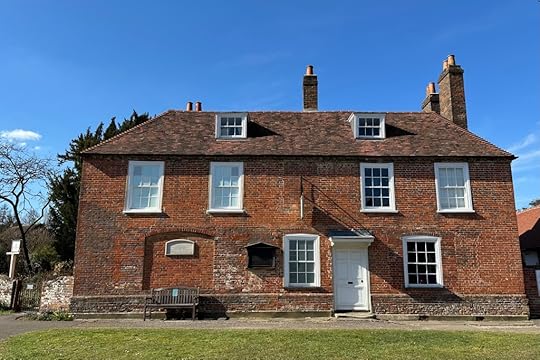
Jane Austen’s House Museum
My daughter and I took the train from London to Alton and enjoyed walking from the Alton station to Chawton. Daffodils! Primroses! Hyacinths! Sunshine! A visit with cousins we hadn’t seen in years! And the pleasure of touring Jane Austen’s House. I took tons of pictures, and I’ll share a few of the best ones with you here.





Tea at Cassandra’s Cup, across the street from the House. My cousins gave me an early edition of Catherine Parr Traill’s book The Backwoods of Canada.


“But now you love a hyacinth. So much the better. You have gained a new source of enjoyment, and it is well to have as many holds upon happiness as possible.”
– Henry Tilney to Catherine Morland in Jane Austen’s Northanger Abbey (Volume 2, Chapter 7)
Thanks so much for visiting Chawton with me!
If you enjoyed this post, I hope you’ll consider recommending it to a friend. If you aren’t yet a subscriber, please sign up.
Here are the links to the last two posts, in case you missed them:
Anne Shirley and “Old St. John’s Graveyard”
Jeanne Birdsall on Jane Austen’s Novels: “my lodestones”
Read more about my books, including St. Paul’s in the Grand Parade, Jane Austen’s Philosophy of the Virtues, and Jane Austen and the North Atlantic, here.
Copyright Sarah Emsley 2025 ~ All rights reserved. No AI training: material on http://www.sarahemsley.com may not be used to “train” generative AI technologies.
April 2, 2025
Anne Shirley and “Old St. John’s Graveyard”
Every time I pass the Old Burying Ground on Barrington Street in Halifax, which was fictionalized as Old St. John’s Graveyard in L.M. Montgomery’s Anne of the Island, I picture Anne Shirley sitting on one of the gravestones.
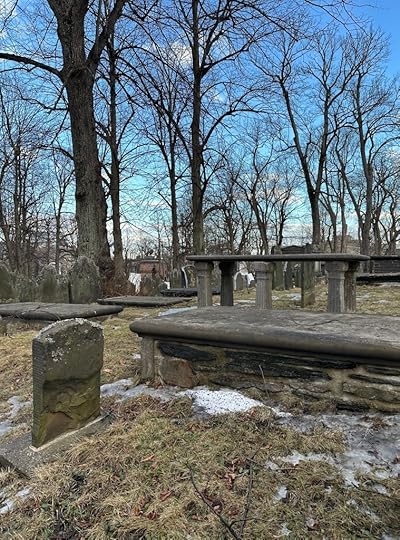
“I don’t know that a graveyard is a very good place to go to get cheered up,” Anne says, “but it seems the only get-at-able place where there are trees, and trees I must have. I’ll sit on one of those old slabs and shut my eyes and imagine I’m in the Avonlea woods.”

On the north shore of PEI
As Linda Lefler commented on one of my blog posts last month, “I love knowing where the friendly ghosts are.” She, too, thinks of Montgomery and Anne when she’s passing through this part of Halifax.
The Old Burying Ground is a National Historic Site of Canada, and it receives thousands of visitors every year. If you’re interested, you can read more about it on their website, in my book St. Paul’s in the Grand Parade, and in a blog post I wrote several years ago: “Anne of Green Gables and the Old Burying Ground, Halifax.” More than 12,000 people were buried there between 1749, the year Halifax was founded, and 1844, when the graveyard closed to burials.

Welsford-Parker Monument, Old Burying Ground
If you enjoyed this post, I hope you’ll consider recommending it to a friend. If you aren’t yet a subscriber, please sign up.
Here are the links to the last two posts, in case you missed them:
Jeanne Birdsall on Jane Austen’s Novels: “my lodestones”
The Appeal of Writing by Hand in a Notebook
Read more about my books, including St. Paul’s in the Grand Parade, Jane Austen’s Philosophy of the Virtues, and Jane Austen and the North Atlantic, here.
Copyright Sarah Emsley 2025 ~ All rights reserved. No AI training: material on http://www.sarahemsley.com may not be used to “train” generative AI technologies.
March 31, 2025
Jeanne Birdsall on Jane Austen’s Novels: “my lodestones”
I’m a longtime fan of Jeanne Birdsall’s award-winning Penderwicks series, as is my daughter, and I was thrilled when Birdsall accepted the invitation to write a reflection for “Unexpectedly Austen,” the series Liz Philosophos Cooper and I are co-editing for the Jane Austen Society of North America throughout this 250th anniversary year.

Birdsall says she reads “good books . . . over and over, hoping they’ll improve my work. Of these, Jane Austen’s are among my favourites, my lodestones. I don’t try to emulate her—that would be foolish and arrogant—but do slip her in when I can. In my saga of a family named Penderwick, one character reads Sense and Sensibility while another (named Jane) writes a play called Sisters and Sacrifice, a possible alternate title for Austen’s book, though I didn’t figure that out until it had settled into my manuscript.”
The March installment of “Unexpectedly Austen” also includes comments from Taylor Swift, Ian McEwan, and Margaret Drabble. Swift says Ang Lee’s adaptation of Sense and Sensibility inspired her when she was creating her album Evermore, while McEwan names Northanger Abbey as an influence on his novel Atonement and Drabble says of her own novels that they are all “a dialogue with Jane Austen.” Read their comments and Birdsall’s reflections in full on the JASNA website.
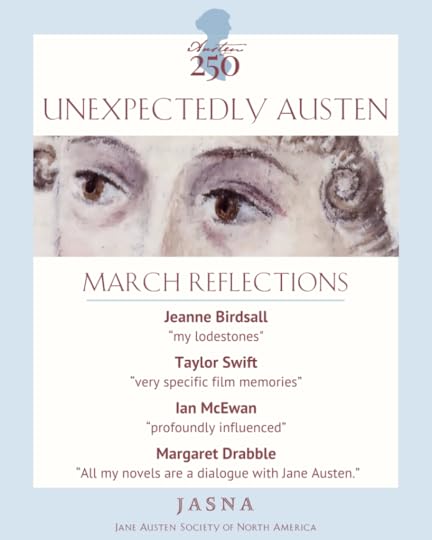
I wrote about the second novel in the Penderwicks series here on my blog back in 2012, when my family and I were listening to the audiobook in the car, and again in 2018, after a walk with my friend Marianne. Both posts include several photos of autumn leaves because of Marianne Dashwood’s “passion for dead leaves.”
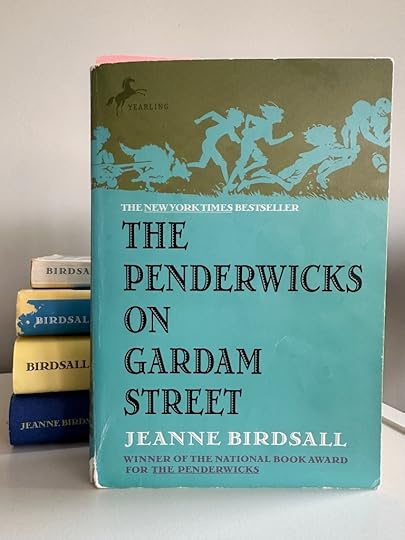
In The Penderwicks on Gardam Street, the widowed Mr. Penderwick claims to be going on dates with a mysterious woman named Marianne who “likes taking walks” and “doesn’t like flannel.” His daughter Jane finds a copy of Sense and Sensibility in his study.
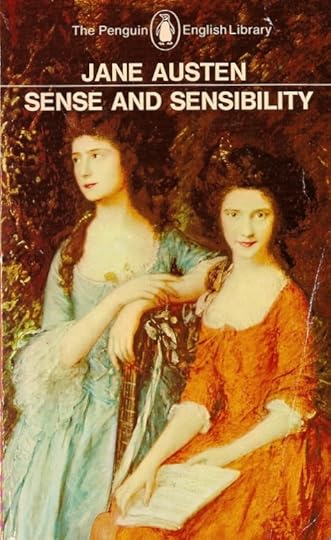
Instead of adding more pictures of autumn leaves to this post, I’ll share with you some recent photos of snowdrops and crocuses (with last year’s dead leaves), taken in my neighbourhood. I’m glad spring has arrived in Nova Scotia.


If you enjoyed this post, I hope you’ll consider recommending it to a friend. If you aren’t yet a subscriber, please sign up.
Here are the links to the last two posts, in case you missed them:
The Appeal of Writing by Hand in a Notebook
Government House and St. Paul’s Church, Halifax
Read more about my books, including St. Paul’s in the Grand Parade, Jane Austen’s Philosophy of the Virtues, and Jane Austen and the North Atlantic, here.
Copyright Sarah Emsley 2025 ~ All rights reserved. No AI training: material on http://www.sarahemsley.com may not be used to “train” generative AI technologies.
March 28, 2025
The Appeal of Writing by Hand in a Notebook
On a recent trip to the library, I picked up The Notebook: A History of Thinking on Paper, by Roland Allen, and I’m looking forward to reading it. I enjoyed my friend Rohan Maitzen’s review. Allen’s main point, she says, “is that this everyday item, which we now take for granted in its multiplicity of forms and uses, really was revolutionary, changing not just the way we make notes but the way we think.”

Allen writes that a notebook “challenges us to create, to explore, to record, to analyse, to think. It lets us draw, compose, organize and remember—even to care for the sick. With it, we can come to know ourselves better, appreciate the good, put the bad in perspective, and live fuller lives.”

The simplicity of the notebook is part of what makes it “endlessly appealing,” Rohan says in her review, “even in this electronic era.” When I’m writing by hand, I often take notes on scraps of paper instead of in a notebook, but all the same, I find it hard to resist a beautiful blank notebook and have filled many of them over the years.

I was tempted to buy all three of these lovely blank books (above) at Jane Austen’s House Museum in Chawton, Hampshire, when I was there last Thursday. I chose only one, pictured at the beginning of this post, which features a reproduction of a wallpaper pattern used in an upstairs bedroom in the House.
I just got home after a wonderful week in England, and I’ll share some of my photos from the trip once I’ve had a chance to sort through them. For now, here are some Chawton daffodils for you:

If you enjoyed this post, I hope you’ll consider recommending it to a friend. If you aren’t yet a subscriber, please sign up.
Here are the links to the last two posts, in case you missed them:
Government House and St. Paul’s Church, Halifax
“The year to appreciate Austen” (John Mullan’s guide on where to start with Jane Austen)
Read more about my books, including St. Paul’s in the Grand Parade, Jane Austen’s Philosophy of the Virtues, and Jane Austen and the North Atlantic, here.
Copyright Sarah Emsley 2025 ~ All rights reserved. No AI training: material on http://www.sarahemsley.com may not be used to “train” generative AI technologies.
March 21, 2025
Government House and St. Paul’s Church, Halifax
Last week I had the privilege and pleasure of giving a talk at Government House in Halifax, NS on the history of St. Paul’s Church, which is located in the heart of the city in the Grand Parade, opposite City Hall.
As I mentioned here last fall, I spoke about St. Paul’s in the Evenings @ Government House series on November 5, 2024. I was delighted to return for an encore presentation on March 11, 2025. It’s wonderful to know that there is a great deal of interest in this topic. At a time when we’re watching the City of Halifax changing rapidly, with older houses and buildings torn down to make way for new developments, exploring the history of St. Paul’s Church and protecting this beautiful, historic place seem more important than ever.

St. Paul’s is currently celebrating its 275th anniversary. The celebrations began last fall, to mark the anniversary of the founding of the parish in 1749, and they’ve continued into 2025, the anniversary of the opening of the church building in 1750.

My talk explored connections between St. Paul’s and Halifax, including the founding of the city, relief efforts after the sinking of RMS Titanic in 1912 and the Halifax Explosion in 1917, and close ties with Government House, the Royal Family, and former Governors and Lieutenant Governors. I also looked at the links between St. Paul’s and Jane Austen’s family: her niece Cassy Austen was baptized there in 1809 and her nephew Charles John Austen, Jr. was married there in 1848.
I’ll write more about the rich and complex history of St. Paul’s in a future post; for now, I’ll share with you some of the photos from this wonderful and memorable evening at Government House. I’m grateful to His Honour, the Honourable Mike Savage, and Her Honour, Ms. Darlene (Killen) Savage, for inviting me to speak and for giving my parents and me a warm welcome. Thanks also to Melissa Goertzen for organizing the event and to Michael Creagen for the photos.
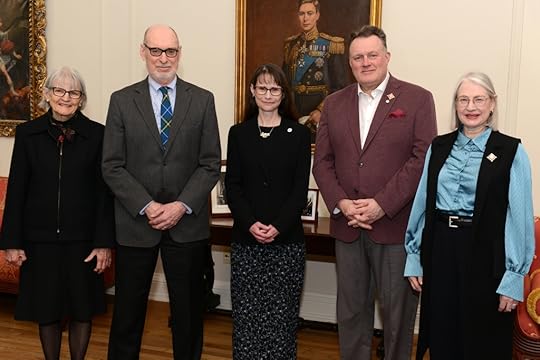



Government House, Halifax, Nova Scotia
If you enjoyed this post, I hope you’ll consider recommending it to a friend. If you aren’t yet a subscriber, please sign up.
Here are the links to the last two posts, in case you missed them:
“The year to appreciate Austen” (John Mullan’s guide on where to start with Jane Austen)
“Sincere work and worthy aspiration and congenial friendship” (The bend in the road at Point Pleasant Park, Green Gables fabric, “Lucy. Maud.,” and the Anne of Green Gables manuscript)
Read more about my books, including St. Paul’s in the Grand Parade, Jane Austen’s Philosophy of the Virtues, and Jane Austen and the North Atlantic, here.
Copyright Sarah Emsley 2025 ~ All rights reserved. No AI training: material on http://www.sarahemsley.com may not be used to “train” generative AI technologies.
March 7, 2025
“The year to appreciate Austen”
My daughter gave me a beautiful copy of Jane Austen’s Lady Susan recently, and I was glad to see this hilarious novella included in John Mullan’s guide to Austen’s writing: he says that “Lady Susan’s wittily cynical letters to her confidante Mrs Johnson (Alicia) are a devilish hoot” (“Where to start with: Jane Austen,” published in The Guardian last month).
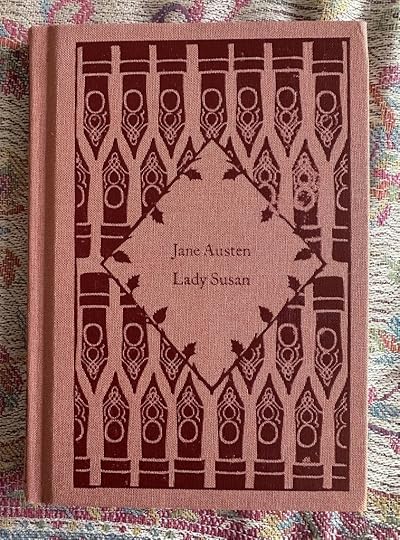
I also liked Mullan’s description of Fanny Price as a “true heroine,” who “must stay true to herself, while observing the idiocies of the entitled Bertrams, who have adopted her, and circumventing the schemes of the charming but diabolical Mary Crawford.”
As the subtitle for the piece in The Guardian says, “This is the year to appreciate Austen.” John Mullan will be a plenary speaker at the Jane Austen Society of North America AGM in Baltimore, MD, in October. The theme is “Austen at 250: No check to my Genius from beginning to end.” If you haven’t seen it already, you can find the AGM Preview Brochure on the JASNA website.
I’ll end with a photo I took in Mahone Bay, Nova Scotia, last Saturday. I’m longing for blue skies, but there’s beauty in those shades of white and grey, too.

If you enjoyed this post, I hope you’ll consider recommending it to a friend. If you aren’t yet a subscriber, please sign up.
Here are the links to the last two posts, in case you missed them:
“Sincere work and worthy aspiration and congenial friendship” (The bend in the road at Point Pleasant Park, Green Gables fabric, “Lucy. Maud.,” and the Anne of Green Gables manuscript)
“Following the path” (photos from a hike at Graves Island)
Read more about my books, including St. Paul’s in the Grand Parade, Jane Austen’s Philosophy of the Virtues, and Jane Austen and the North Atlantic, here.
Copyright Sarah Emsley 2025 ~ All rights reserved. No AI training: material on http://www.sarahemsley.com may not be used to “train” generative AI technologies.
February 28, 2025
“Sincere work and worthy aspiration and congenial friendship”
Last week, when I was looking back at photos from a hike at Graves Island, I also found this picture I took of “the bend in the road” at Point Pleasant Park here in Halifax.

As I’ve mentioned here before, L.M. Montgomery was fascinated by the idea of the bend in the road, and her Red Scrapbook includes a Notman Studio image of this same path in Point Pleasant.
Elizabeth Epperly writes in Imagining Anne: The Island Scrapbooks of L.M. Montgomery that the phrase “The Bend of the Road” appears in a poem by Grace Denio Lichfield, which Montgomery also included in her Red Scrapbook. The last chapter of Montgomery’s novel Anne of Green Gables is entitled “The Bend in the Road.”
My friend Marilyn Smulders (who wrote a guest post on “Sense and Sensibility and Sewing” for my S&S series last summer) sent me a beautiful present a few weeks ago: a small fabric bag made using “Green Gables” fabric designed by Brianna Corr Scott.

I read recently that Megan Follows, who played Anne Shirley in the 1985 adaptation of Anne of Green Gables, will play L.M. Montgomery in a new series called “Lucy. Maud.” Follows expects that those who aren’t familiar with Montgomery’s work will still enjoy watching “a show about the power of creativity as a saving grace and as a means of exploring the world and finding your voice. Even when you’re up against extraordinary odds.”
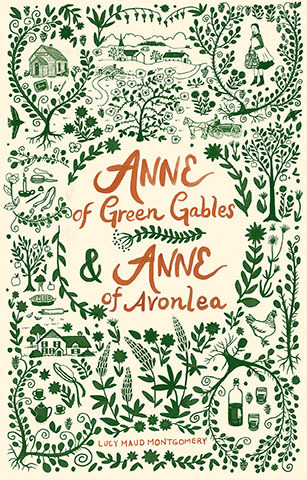
I was delighted to learn late last year that the manuscript of Anne of Green Gables has been added to a United Nations register that highlights Canadian heritage and aims to “safeguard and promote access to documentary heritage of universal value.”
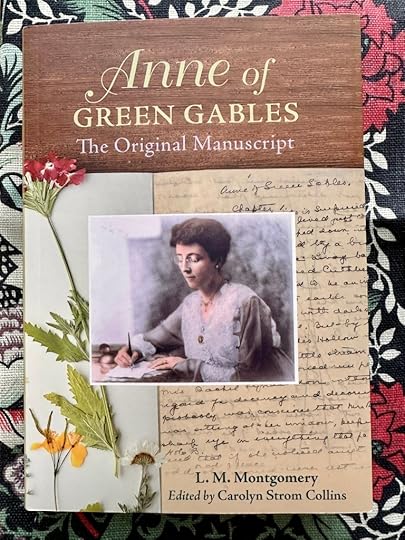
The original manuscript of Anne of Green Gables, published by Nimbus, was edited by Carolyn Strom Collins and copyedited by Marianne Ward (who wrote a guest post for my LMM at 150 series last fall: “L.M. Montgomery and Emily Carr, Worshippers of the Woods”).
“Dear old world,” Anne murmurs near the end of the last chapter of the novel, “you are very lovely, and I am glad to be alive in you.” Although her plans for the future have changed, she believes that “The joy of sincere work and worthy aspiration and congenial friendship were to be hers; nothing could rob her of her birthright of fancy or her ideal world of dreams.”
If you enjoyed this post, I hope you’ll consider recommending it to a friend. If you aren’t yet a subscriber, please sign up!
Here are the links to the last two posts, in case you missed them:
“Following the path” (photos from a hike at Graves Island)
Adjoa Andoh’s tribute to Jane Austen (Andoh praises “the bite of the Austen voice”)
Read more about my books, including St. Paul’s in the Grand Parade, Jane Austen’s Philosophy of the Virtues, and Jane Austen and the North Atlantic, here.
Copyright Sarah Emsley 2025 ~ All rights reserved. No AI training: material on http://www.sarahemsley.com may not be used to “train” generative AI technologies.
February 21, 2025
“Following the path”
“Write the way you can and not the way you think you’re supposed to,” says Susanna Clarke, author of Jonathan Strange & Mr. Norrell and, most recently, The Wood at Midwinter. “I’ve only ever had any success by doing my own weird thing, following the path that’s in front of me.”
Clarke sounds like Jane Austen to me: “I must keep to my own style & go on in my own Way,” Austen wrote to the Prince Regent’s librarian, James Stanier Clarke, in 1816. “And though I may never succeed again in that,” she said, “I am convinced that I should totally fail in any other.” (Stanier Clarke had suggested she write a “Historical Romance illustrative of the History of the august house of Cobourg.” You can see photos of Austen’s letter on the website of Jane Austen’s House Museum.)
Here’s what I saw on the (literal, rather than metaphorical) path in front of me on a hike at Graves Island, on the south shore of Nova Scotia, a couple of months ago. The sky was overcast when we set out, but by the time we had hiked around the island, the sun had come out.
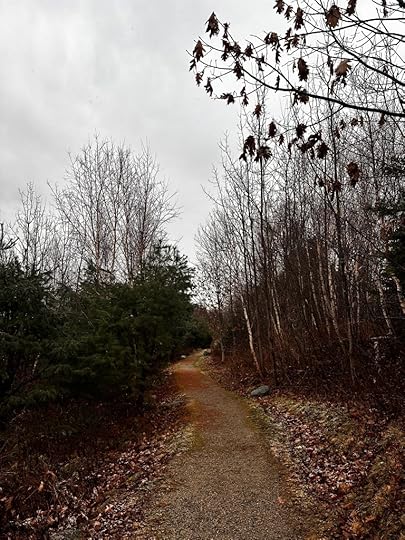


We’ve had a great deal of snow and ice here in Nova Scotia recently, and I enjoyed looking back at these photos from a time when the hiking trails were still clear. I’m looking forward to visiting Graves Island and other favourite hiking spots again before too long. These parks are such a precious resource.
If you enjoyed this post, I hope you’ll consider recommending it to a friend. If you aren’t yet a subscriber, please sign up!
Here are the links to the last two posts, in case you missed them:
Adjoa Andoh’s tribute to Jane Austen (Andoh praises “the bite of the Austen voice”)
“A more convincing consolation” (on reading Austen for comfort)
Read more about my books, including St. Paul’s in the Grand Parade, Jane Austen’s Philosophy of the Virtues, and Jane Austen and the North Atlantic, here.
Copyright Sarah Emsley 2025 ~ All rights reserved. No AI training: material on http://www.sarahemsley.com may not be used to “train” generative AI technologies.
February 18, 2025
Adjoa Andoh’s tribute to Jane Austen
Adjoa Andoh, well known for playing Lady Danbury in Bridgerton, praises “the bite of the Austen voice” in the tribute she wrote for “Unexpectedly Austen,” the series I’m co-editing with Liz Philosophos Cooper for the Jane Austen Society of North America. She says, “I have yet to see a stage or film version of one of Austen’s novels that successfully communicates the wit, humour and acerbic voice of the narrator who is Austen.”
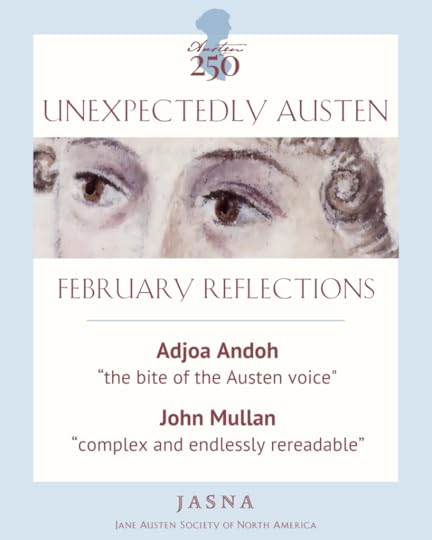
Read the full tribute in the February installment of “Unexpectedly Austen,” along with a quotation from John Mullan, Lord Northcliffe Chair of Modern English Literature at University College London, who credits his students with helping him discover “how complex and endlessly re-readable [Austen’s] apparently simple stories were.”

If you’re celebrating Jane Austen’s 250th birthday this year, I’d love to hear about your plans.
I was interested to see “Jane Austen’s England” featured in “52 Places to Go in 2025” in the New York Times. AnneLise Sorensen highlights the exhibitions and themed festivals at Jane Austen’s House, along with several other exhibitions and events. (Like many Janeites, I’m planning a trip to England this year—more on that in a future post.)
In a list of the Austen characters that have “enchanted generations of readers,” the first example given in this recent BBC article entitled “How to celebrate Jane Austen on her 250th birthday” is “the dashing John Willoughby.” I think I would have expected to see one of the heroines or Mr. Darcy named first. Last weekend, The Guardian featured a list of favourite Austen characters chosen by Helen Fielding, Olivia Williams, Greta Scacchi, Andrew Davies, and several others. If you were making a list of “Enchanting Austen Characters” or “Favourite Austen Characters,” who would appear at the top? I’m with Abi Morgan, who says, “I’m choosing the most obvious Austen character, Elizabeth Bennet, but I’d be lying if I chose anyone else.”
One of the new books about Austen that I’m especially excited about this year is Devoney Looser’s Wild for Austen: A Rebellious, Subversive, and Untamed Jane, an exploration of “the fascinating and fantastical journey her legacy has taken over the past 250 years.” I’ve pre-ordered and can’t wait to read it. Read more about the book in this recent post by Laurel Ann Nattress of Austenprose.
Devoney wrote a guest post on the controversial topic of “Rears and Vices” for the series I hosted celebrating the 200th anniversary of Mansfield Park. She says that Mary Crawford “coyly invites her audience of listeners (just as Austen invites her audience of readers) to conclude precisely what she says she doesn’t want to be suspected of—that she’s uttering a pun. The question for us as readers today is, ‘Precisely how off-color is her pun?’”

If you enjoyed this post, I hope you’ll consider recommending it to a friend. If you aren’t yet a subscriber, please sign up!
Here are the links to the last two posts, in case you missed them:
“A more convincing consolation” (on reading Austen for comfort)
“My winter walk” (Mr. Woodhouse, Cowper, Point Pleasant Park in winter)
Read more about my books, including St. Paul’s in the Grand Parade, Jane Austen’s Philosophy of the Virtues, and Jane Austen and the North Atlantic, here.
Copyright Sarah Emsley 2025 ~ All rights reserved. No AI training: material on http://www.sarahemsley.com may not be used to “train” generative AI technologies.



